Analyzing the Impact of Workplace Change on Employees and Orgs
VerifiedAdded on 2020/05/16
|45
|9308
|49
Report
AI Summary
This report examines the impact of workplace changes on both employees and organizations. It begins with an introduction outlining the background, rationale, aims, objectives, and research questions, followed by a literature review exploring factors to consider, diversity management concepts, organizational change types, and employee perceptions. The methodology section details the research approach, design, data collection, analysis methods, and ethical considerations. The data analysis and discussion chapter presents frequency, factor, correlation, and regression analyses. The conclusion addresses the research objectives, provides recommendations, and suggests future research directions. The study assesses various factors, benefits, limitations, and tools related to workplace changes, ultimately aiming to provide management with guidelines for efficient workplace management. It investigates the impact of these changes on employee motivation and organizational performance, highlighting the importance of understanding and adapting to evolving workplace dynamics.
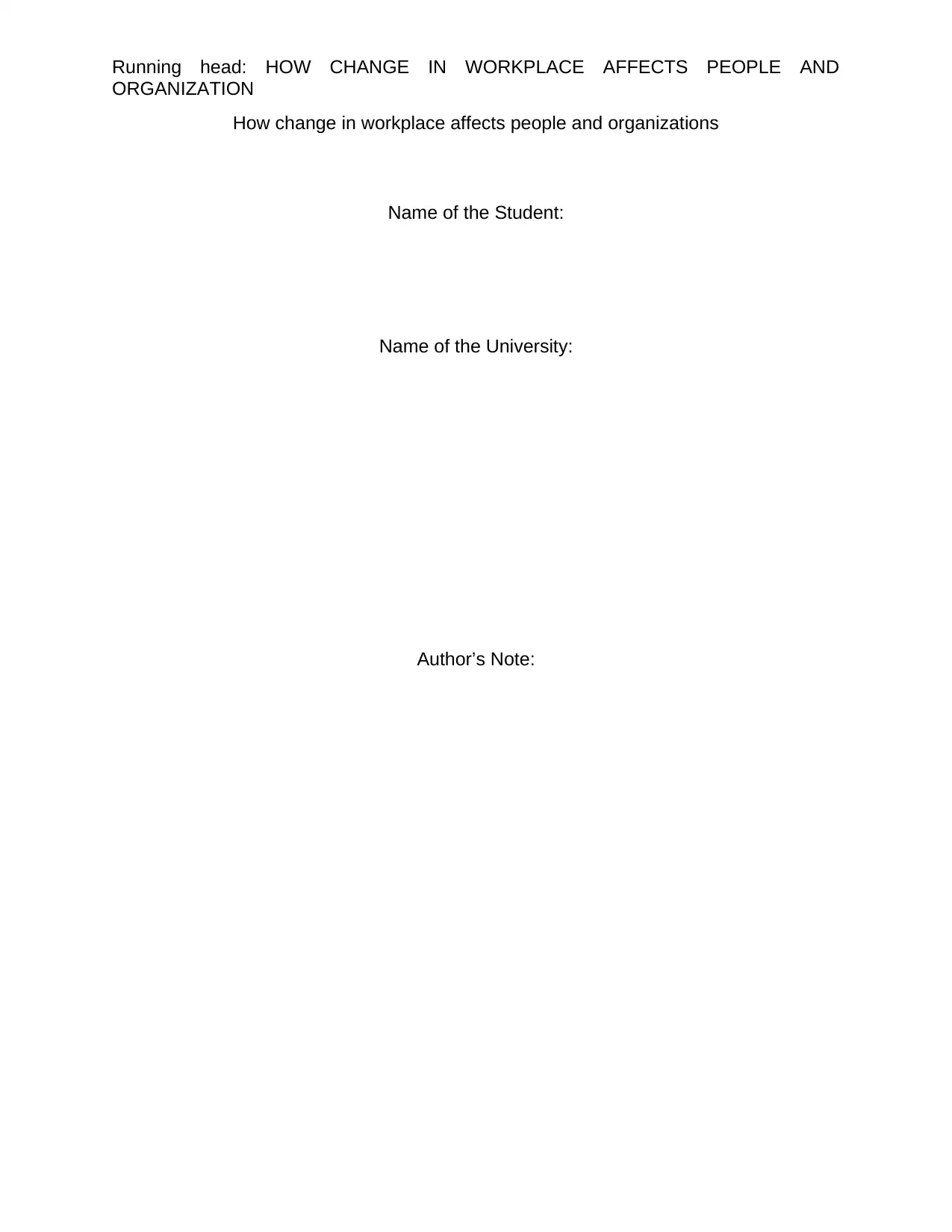
Running head: HOW CHANGE IN WORKPLACE AFFECTS PEOPLE AND
ORGANIZATION
How change in workplace affects people and organizations
Name of the Student:
Name of the University:
Author’s Note:
ORGANIZATION
How change in workplace affects people and organizations
Name of the Student:
Name of the University:
Author’s Note:
Paraphrase This Document
Need a fresh take? Get an instant paraphrase of this document with our AI Paraphraser
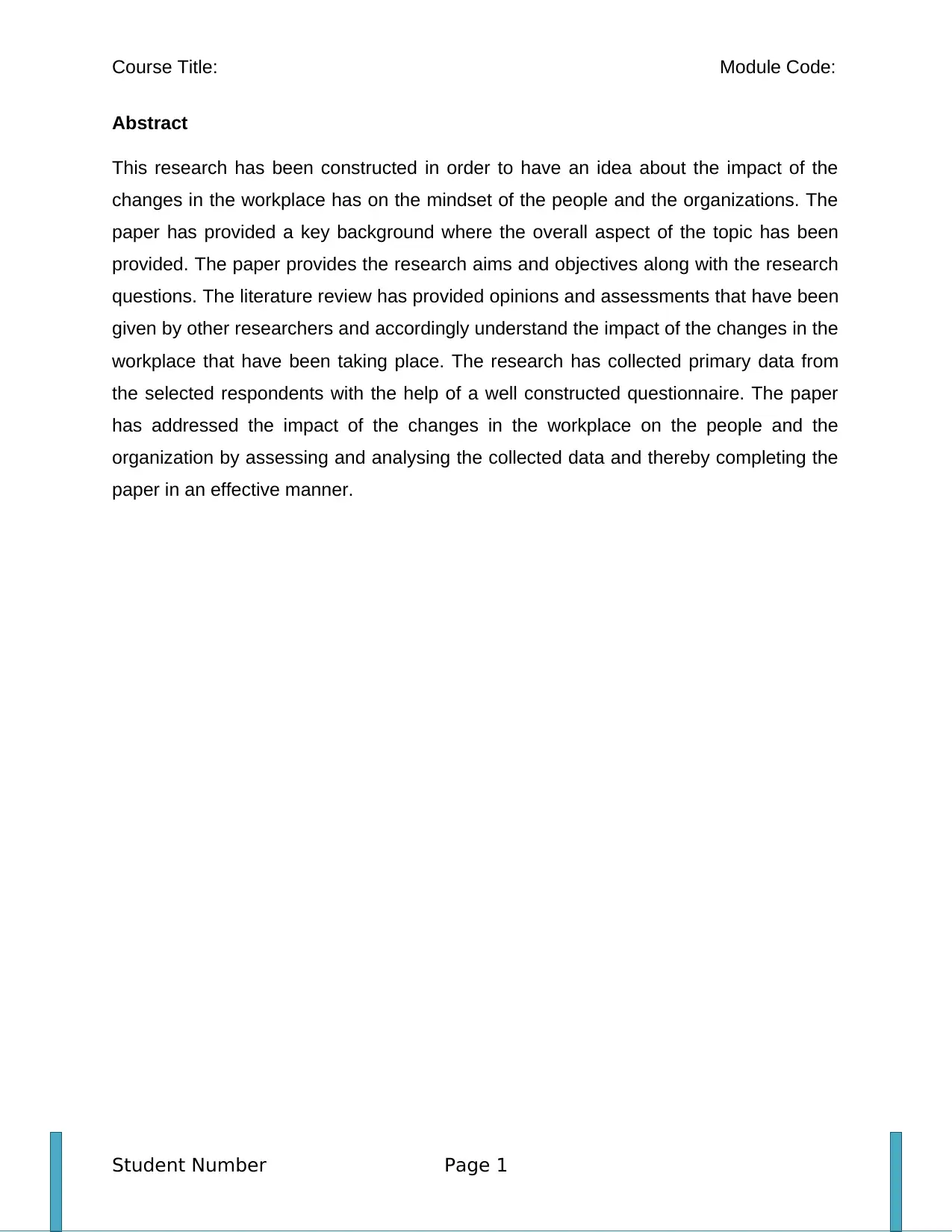
Course Title: Module Code:
Abstract
This research has been constructed in order to have an idea about the impact of the
changes in the workplace has on the mindset of the people and the organizations. The
paper has provided a key background where the overall aspect of the topic has been
provided. The paper provides the research aims and objectives along with the research
questions. The literature review has provided opinions and assessments that have been
given by other researchers and accordingly understand the impact of the changes in the
workplace that have been taking place. The research has collected primary data from
the selected respondents with the help of a well constructed questionnaire. The paper
has addressed the impact of the changes in the workplace on the people and the
organization by assessing and analysing the collected data and thereby completing the
paper in an effective manner.
Student Number Page 1
Abstract
This research has been constructed in order to have an idea about the impact of the
changes in the workplace has on the mindset of the people and the organizations. The
paper has provided a key background where the overall aspect of the topic has been
provided. The paper provides the research aims and objectives along with the research
questions. The literature review has provided opinions and assessments that have been
given by other researchers and accordingly understand the impact of the changes in the
workplace that have been taking place. The research has collected primary data from
the selected respondents with the help of a well constructed questionnaire. The paper
has addressed the impact of the changes in the workplace on the people and the
organization by assessing and analysing the collected data and thereby completing the
paper in an effective manner.
Student Number Page 1
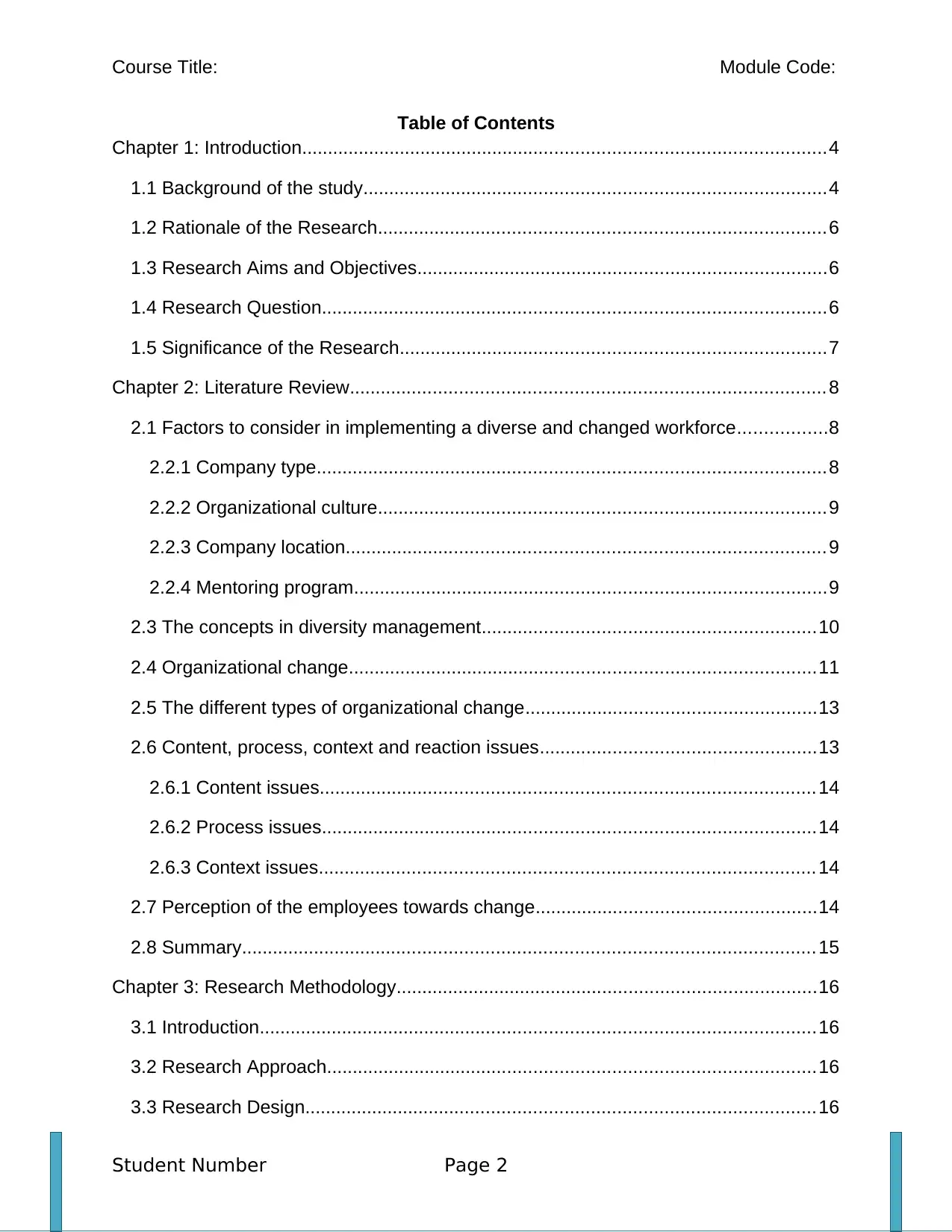
Course Title: Module Code:
Table of Contents
Chapter 1: Introduction.....................................................................................................4
1.1 Background of the study.........................................................................................4
1.2 Rationale of the Research......................................................................................6
1.3 Research Aims and Objectives...............................................................................6
1.4 Research Question.................................................................................................6
1.5 Significance of the Research..................................................................................7
Chapter 2: Literature Review...........................................................................................8
2.1 Factors to consider in implementing a diverse and changed workforce.................8
2.2.1 Company type..................................................................................................8
2.2.2 Organizational culture......................................................................................9
2.2.3 Company location............................................................................................9
2.2.4 Mentoring program...........................................................................................9
2.3 The concepts in diversity management................................................................10
2.4 Organizational change..........................................................................................11
2.5 The different types of organizational change........................................................13
2.6 Content, process, context and reaction issues.....................................................13
2.6.1 Content issues............................................................................................... 14
2.6.2 Process issues...............................................................................................14
2.6.3 Context issues............................................................................................... 14
2.7 Perception of the employees towards change......................................................14
2.8 Summary.............................................................................................................. 15
Chapter 3: Research Methodology.................................................................................16
3.1 Introduction...........................................................................................................16
3.2 Research Approach..............................................................................................16
3.3 Research Design..................................................................................................16
Student Number Page 2
Table of Contents
Chapter 1: Introduction.....................................................................................................4
1.1 Background of the study.........................................................................................4
1.2 Rationale of the Research......................................................................................6
1.3 Research Aims and Objectives...............................................................................6
1.4 Research Question.................................................................................................6
1.5 Significance of the Research..................................................................................7
Chapter 2: Literature Review...........................................................................................8
2.1 Factors to consider in implementing a diverse and changed workforce.................8
2.2.1 Company type..................................................................................................8
2.2.2 Organizational culture......................................................................................9
2.2.3 Company location............................................................................................9
2.2.4 Mentoring program...........................................................................................9
2.3 The concepts in diversity management................................................................10
2.4 Organizational change..........................................................................................11
2.5 The different types of organizational change........................................................13
2.6 Content, process, context and reaction issues.....................................................13
2.6.1 Content issues............................................................................................... 14
2.6.2 Process issues...............................................................................................14
2.6.3 Context issues............................................................................................... 14
2.7 Perception of the employees towards change......................................................14
2.8 Summary.............................................................................................................. 15
Chapter 3: Research Methodology.................................................................................16
3.1 Introduction...........................................................................................................16
3.2 Research Approach..............................................................................................16
3.3 Research Design..................................................................................................16
Student Number Page 2
⊘ This is a preview!⊘
Do you want full access?
Subscribe today to unlock all pages.

Trusted by 1+ million students worldwide
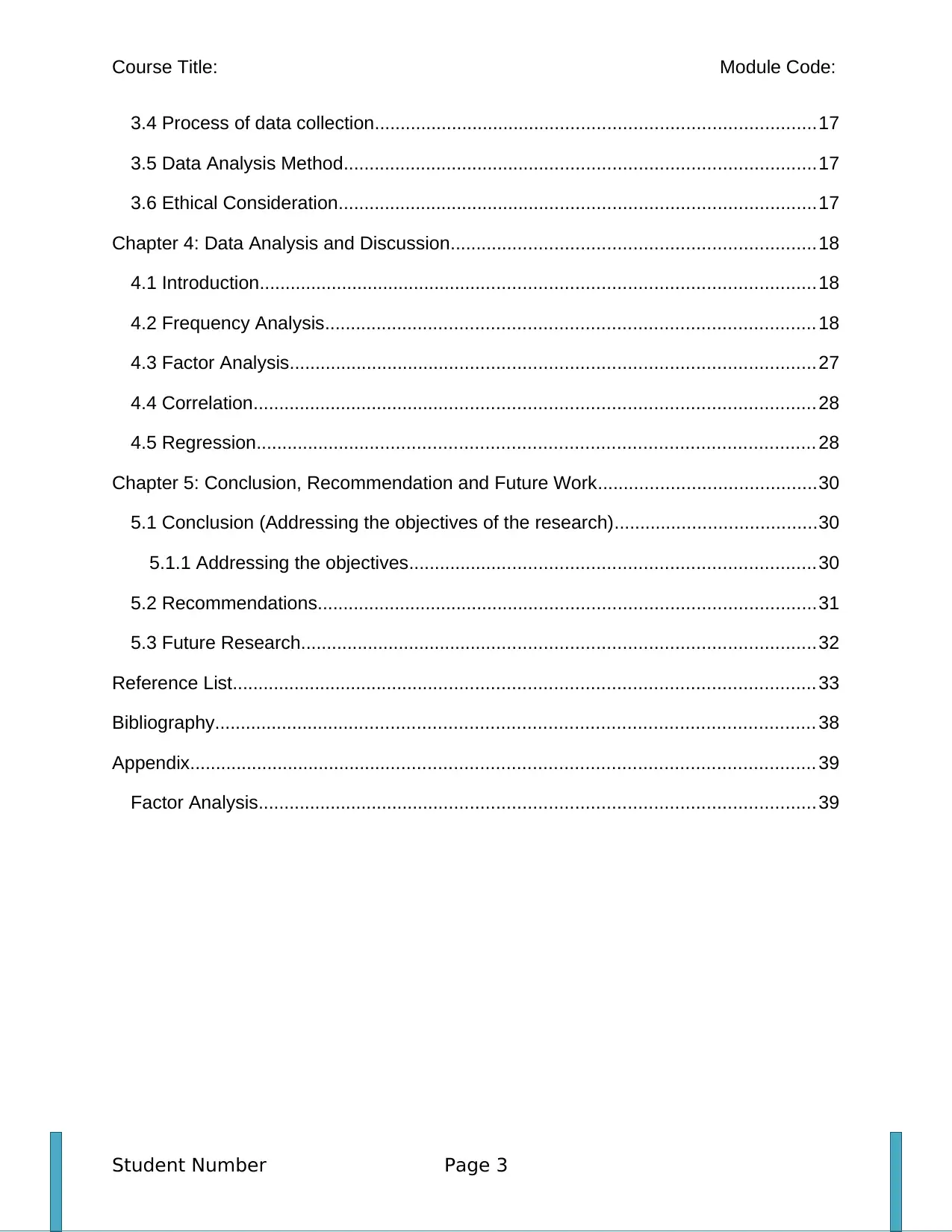
Course Title: Module Code:
3.4 Process of data collection.....................................................................................17
3.5 Data Analysis Method...........................................................................................17
3.6 Ethical Consideration............................................................................................17
Chapter 4: Data Analysis and Discussion......................................................................18
4.1 Introduction...........................................................................................................18
4.2 Frequency Analysis.............................................................................................. 18
4.3 Factor Analysis.....................................................................................................27
4.4 Correlation............................................................................................................28
4.5 Regression........................................................................................................... 28
Chapter 5: Conclusion, Recommendation and Future Work..........................................30
5.1 Conclusion (Addressing the objectives of the research).......................................30
5.1.1 Addressing the objectives..............................................................................30
5.2 Recommendations................................................................................................31
5.3 Future Research...................................................................................................32
Reference List................................................................................................................ 33
Bibliography................................................................................................................... 38
Appendix........................................................................................................................ 39
Factor Analysis...........................................................................................................39
Student Number Page 3
3.4 Process of data collection.....................................................................................17
3.5 Data Analysis Method...........................................................................................17
3.6 Ethical Consideration............................................................................................17
Chapter 4: Data Analysis and Discussion......................................................................18
4.1 Introduction...........................................................................................................18
4.2 Frequency Analysis.............................................................................................. 18
4.3 Factor Analysis.....................................................................................................27
4.4 Correlation............................................................................................................28
4.5 Regression........................................................................................................... 28
Chapter 5: Conclusion, Recommendation and Future Work..........................................30
5.1 Conclusion (Addressing the objectives of the research).......................................30
5.1.1 Addressing the objectives..............................................................................30
5.2 Recommendations................................................................................................31
5.3 Future Research...................................................................................................32
Reference List................................................................................................................ 33
Bibliography................................................................................................................... 38
Appendix........................................................................................................................ 39
Factor Analysis...........................................................................................................39
Student Number Page 3
Paraphrase This Document
Need a fresh take? Get an instant paraphrase of this document with our AI Paraphraser
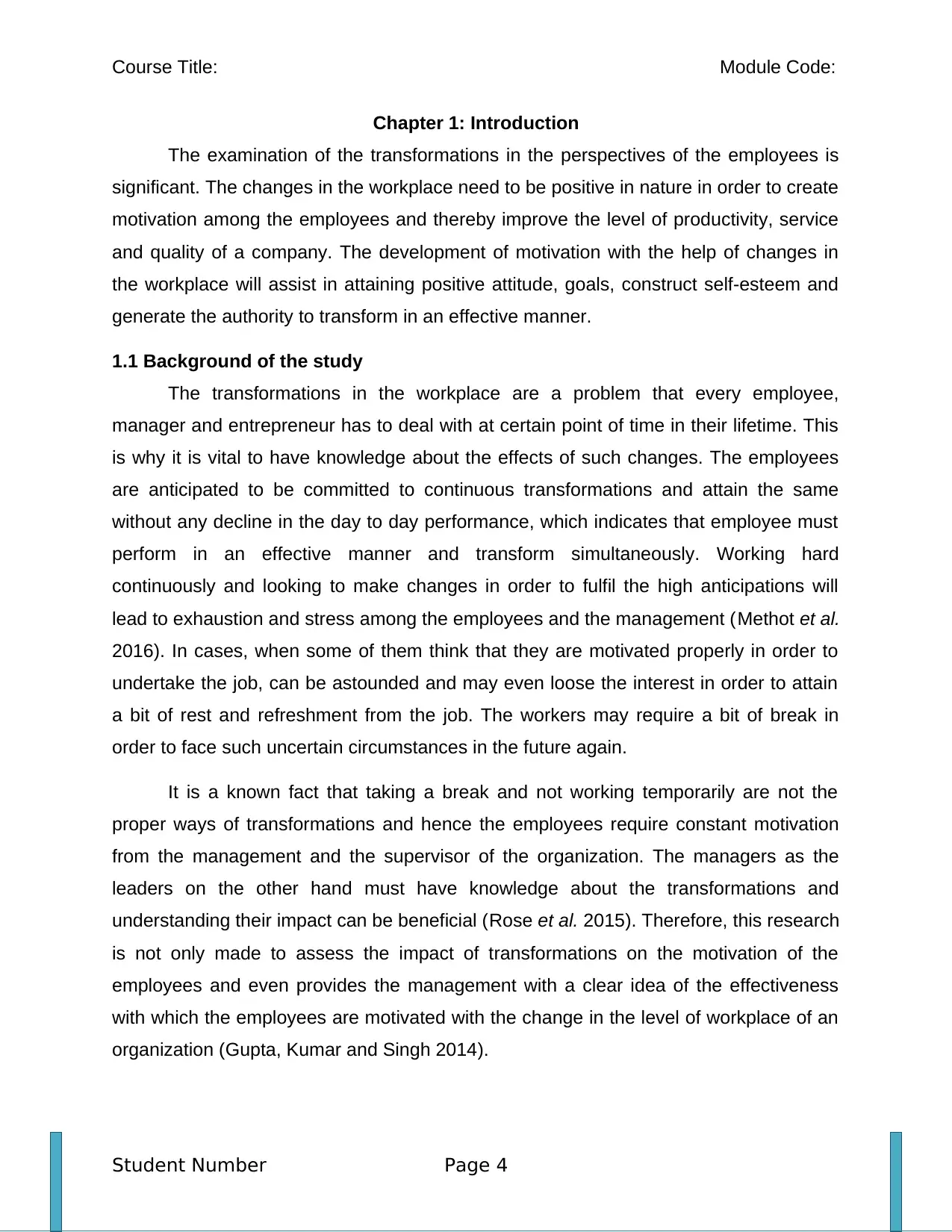
Course Title: Module Code:
Chapter 1: Introduction
The examination of the transformations in the perspectives of the employees is
significant. The changes in the workplace need to be positive in nature in order to create
motivation among the employees and thereby improve the level of productivity, service
and quality of a company. The development of motivation with the help of changes in
the workplace will assist in attaining positive attitude, goals, construct self-esteem and
generate the authority to transform in an effective manner.
1.1 Background of the study
The transformations in the workplace are a problem that every employee,
manager and entrepreneur has to deal with at certain point of time in their lifetime. This
is why it is vital to have knowledge about the effects of such changes. The employees
are anticipated to be committed to continuous transformations and attain the same
without any decline in the day to day performance, which indicates that employee must
perform in an effective manner and transform simultaneously. Working hard
continuously and looking to make changes in order to fulfil the high anticipations will
lead to exhaustion and stress among the employees and the management (Methot et al.
2016). In cases, when some of them think that they are motivated properly in order to
undertake the job, can be astounded and may even loose the interest in order to attain
a bit of rest and refreshment from the job. The workers may require a bit of break in
order to face such uncertain circumstances in the future again.
It is a known fact that taking a break and not working temporarily are not the
proper ways of transformations and hence the employees require constant motivation
from the management and the supervisor of the organization. The managers as the
leaders on the other hand must have knowledge about the transformations and
understanding their impact can be beneficial (Rose et al. 2015). Therefore, this research
is not only made to assess the impact of transformations on the motivation of the
employees and even provides the management with a clear idea of the effectiveness
with which the employees are motivated with the change in the level of workplace of an
organization (Gupta, Kumar and Singh 2014).
Student Number Page 4
Chapter 1: Introduction
The examination of the transformations in the perspectives of the employees is
significant. The changes in the workplace need to be positive in nature in order to create
motivation among the employees and thereby improve the level of productivity, service
and quality of a company. The development of motivation with the help of changes in
the workplace will assist in attaining positive attitude, goals, construct self-esteem and
generate the authority to transform in an effective manner.
1.1 Background of the study
The transformations in the workplace are a problem that every employee,
manager and entrepreneur has to deal with at certain point of time in their lifetime. This
is why it is vital to have knowledge about the effects of such changes. The employees
are anticipated to be committed to continuous transformations and attain the same
without any decline in the day to day performance, which indicates that employee must
perform in an effective manner and transform simultaneously. Working hard
continuously and looking to make changes in order to fulfil the high anticipations will
lead to exhaustion and stress among the employees and the management (Methot et al.
2016). In cases, when some of them think that they are motivated properly in order to
undertake the job, can be astounded and may even loose the interest in order to attain
a bit of rest and refreshment from the job. The workers may require a bit of break in
order to face such uncertain circumstances in the future again.
It is a known fact that taking a break and not working temporarily are not the
proper ways of transformations and hence the employees require constant motivation
from the management and the supervisor of the organization. The managers as the
leaders on the other hand must have knowledge about the transformations and
understanding their impact can be beneficial (Rose et al. 2015). Therefore, this research
is not only made to assess the impact of transformations on the motivation of the
employees and even provides the management with a clear idea of the effectiveness
with which the employees are motivated with the change in the level of workplace of an
organization (Gupta, Kumar and Singh 2014).
Student Number Page 4
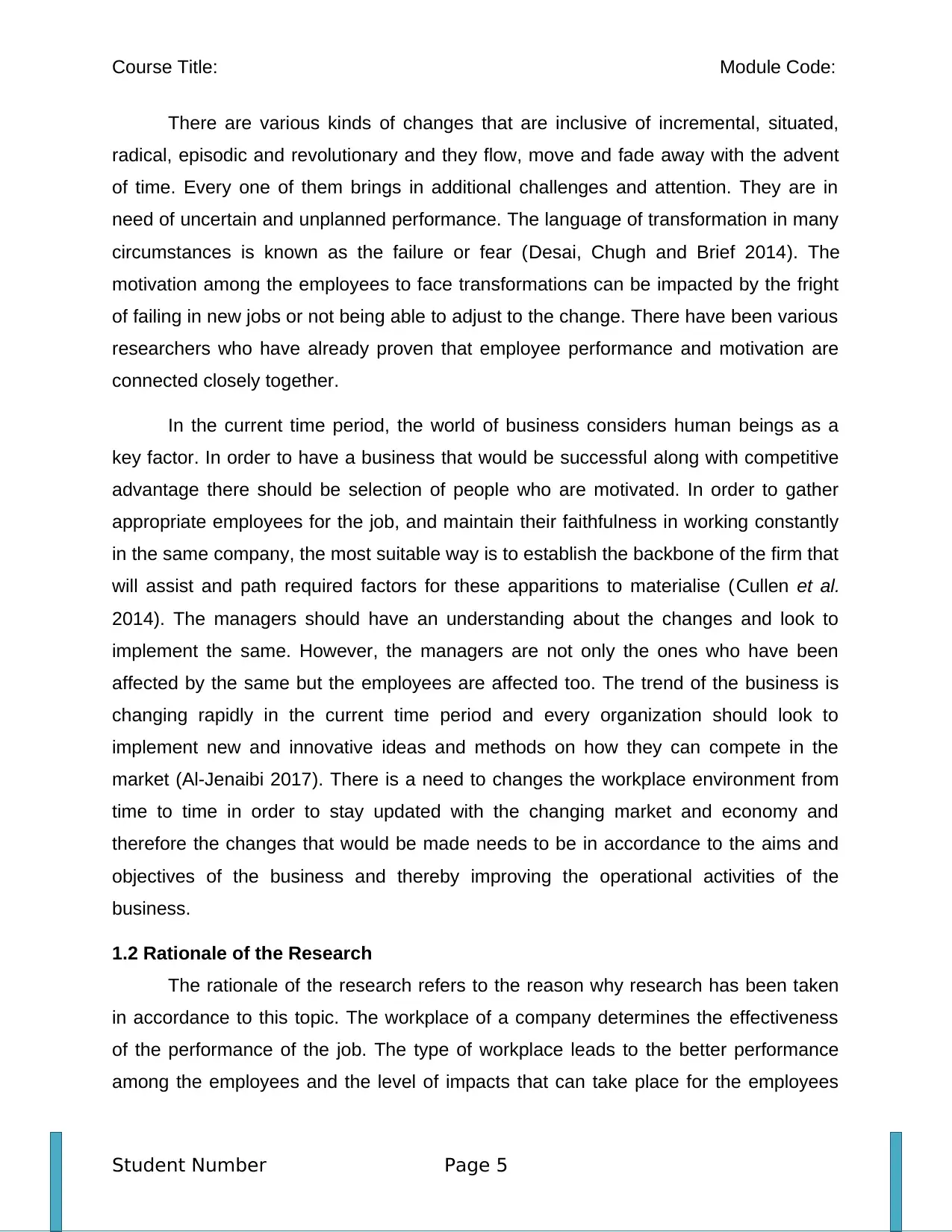
Course Title: Module Code:
There are various kinds of changes that are inclusive of incremental, situated,
radical, episodic and revolutionary and they flow, move and fade away with the advent
of time. Every one of them brings in additional challenges and attention. They are in
need of uncertain and unplanned performance. The language of transformation in many
circumstances is known as the failure or fear (Desai, Chugh and Brief 2014). The
motivation among the employees to face transformations can be impacted by the fright
of failing in new jobs or not being able to adjust to the change. There have been various
researchers who have already proven that employee performance and motivation are
connected closely together.
In the current time period, the world of business considers human beings as a
key factor. In order to have a business that would be successful along with competitive
advantage there should be selection of people who are motivated. In order to gather
appropriate employees for the job, and maintain their faithfulness in working constantly
in the same company, the most suitable way is to establish the backbone of the firm that
will assist and path required factors for these apparitions to materialise (Cullen et al.
2014). The managers should have an understanding about the changes and look to
implement the same. However, the managers are not only the ones who have been
affected by the same but the employees are affected too. The trend of the business is
changing rapidly in the current time period and every organization should look to
implement new and innovative ideas and methods on how they can compete in the
market (Al-Jenaibi 2017). There is a need to changes the workplace environment from
time to time in order to stay updated with the changing market and economy and
therefore the changes that would be made needs to be in accordance to the aims and
objectives of the business and thereby improving the operational activities of the
business.
1.2 Rationale of the Research
The rationale of the research refers to the reason why research has been taken
in accordance to this topic. The workplace of a company determines the effectiveness
of the performance of the job. The type of workplace leads to the better performance
among the employees and the level of impacts that can take place for the employees
Student Number Page 5
There are various kinds of changes that are inclusive of incremental, situated,
radical, episodic and revolutionary and they flow, move and fade away with the advent
of time. Every one of them brings in additional challenges and attention. They are in
need of uncertain and unplanned performance. The language of transformation in many
circumstances is known as the failure or fear (Desai, Chugh and Brief 2014). The
motivation among the employees to face transformations can be impacted by the fright
of failing in new jobs or not being able to adjust to the change. There have been various
researchers who have already proven that employee performance and motivation are
connected closely together.
In the current time period, the world of business considers human beings as a
key factor. In order to have a business that would be successful along with competitive
advantage there should be selection of people who are motivated. In order to gather
appropriate employees for the job, and maintain their faithfulness in working constantly
in the same company, the most suitable way is to establish the backbone of the firm that
will assist and path required factors for these apparitions to materialise (Cullen et al.
2014). The managers should have an understanding about the changes and look to
implement the same. However, the managers are not only the ones who have been
affected by the same but the employees are affected too. The trend of the business is
changing rapidly in the current time period and every organization should look to
implement new and innovative ideas and methods on how they can compete in the
market (Al-Jenaibi 2017). There is a need to changes the workplace environment from
time to time in order to stay updated with the changing market and economy and
therefore the changes that would be made needs to be in accordance to the aims and
objectives of the business and thereby improving the operational activities of the
business.
1.2 Rationale of the Research
The rationale of the research refers to the reason why research has been taken
in accordance to this topic. The workplace of a company determines the effectiveness
of the performance of the job. The type of workplace leads to the better performance
among the employees and the level of impacts that can take place for the employees
Student Number Page 5
⊘ This is a preview!⊘
Do you want full access?
Subscribe today to unlock all pages.

Trusted by 1+ million students worldwide
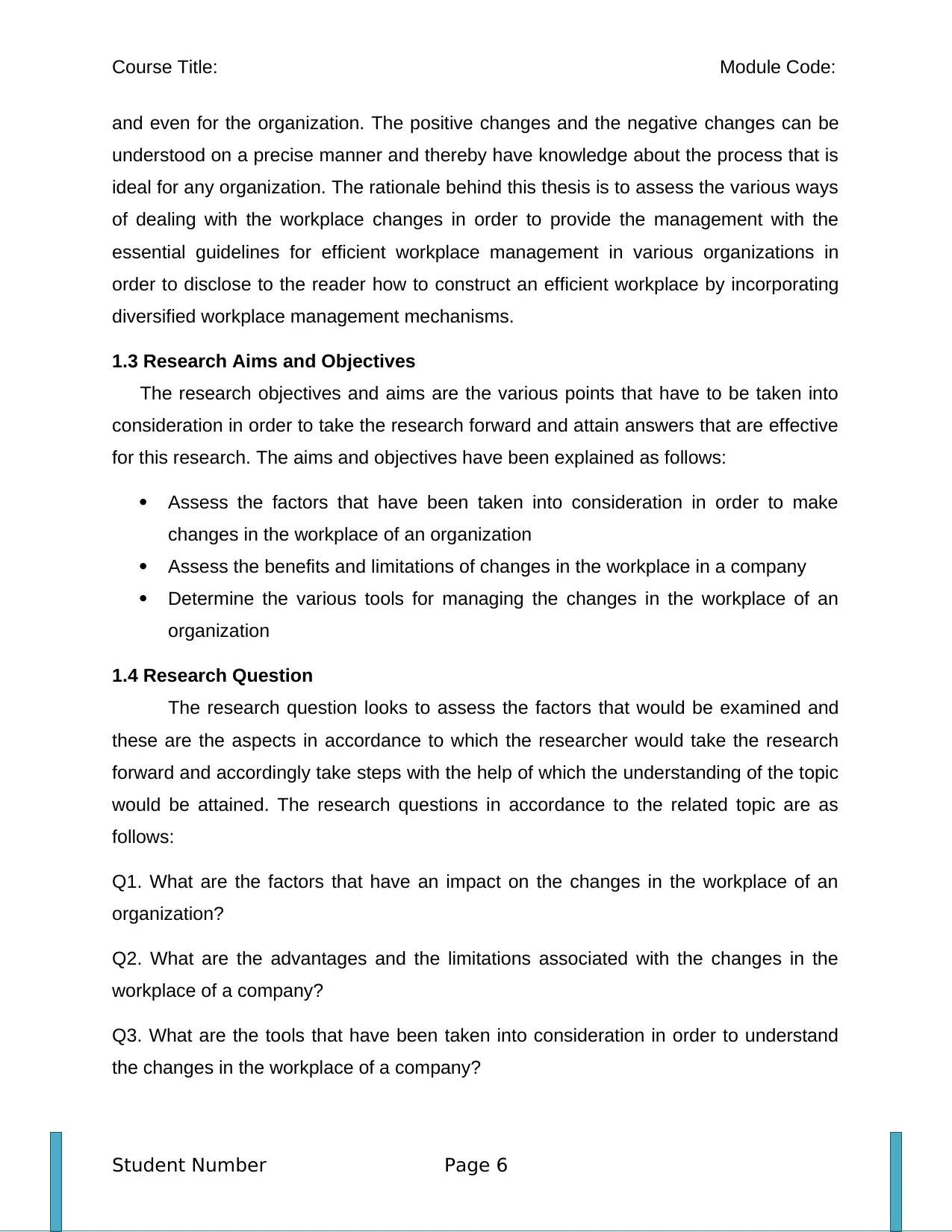
Course Title: Module Code:
and even for the organization. The positive changes and the negative changes can be
understood on a precise manner and thereby have knowledge about the process that is
ideal for any organization. The rationale behind this thesis is to assess the various ways
of dealing with the workplace changes in order to provide the management with the
essential guidelines for efficient workplace management in various organizations in
order to disclose to the reader how to construct an efficient workplace by incorporating
diversified workplace management mechanisms.
1.3 Research Aims and Objectives
The research objectives and aims are the various points that have to be taken into
consideration in order to take the research forward and attain answers that are effective
for this research. The aims and objectives have been explained as follows:
Assess the factors that have been taken into consideration in order to make
changes in the workplace of an organization
Assess the benefits and limitations of changes in the workplace in a company
Determine the various tools for managing the changes in the workplace of an
organization
1.4 Research Question
The research question looks to assess the factors that would be examined and
these are the aspects in accordance to which the researcher would take the research
forward and accordingly take steps with the help of which the understanding of the topic
would be attained. The research questions in accordance to the related topic are as
follows:
Q1. What are the factors that have an impact on the changes in the workplace of an
organization?
Q2. What are the advantages and the limitations associated with the changes in the
workplace of a company?
Q3. What are the tools that have been taken into consideration in order to understand
the changes in the workplace of a company?
Student Number Page 6
and even for the organization. The positive changes and the negative changes can be
understood on a precise manner and thereby have knowledge about the process that is
ideal for any organization. The rationale behind this thesis is to assess the various ways
of dealing with the workplace changes in order to provide the management with the
essential guidelines for efficient workplace management in various organizations in
order to disclose to the reader how to construct an efficient workplace by incorporating
diversified workplace management mechanisms.
1.3 Research Aims and Objectives
The research objectives and aims are the various points that have to be taken into
consideration in order to take the research forward and attain answers that are effective
for this research. The aims and objectives have been explained as follows:
Assess the factors that have been taken into consideration in order to make
changes in the workplace of an organization
Assess the benefits and limitations of changes in the workplace in a company
Determine the various tools for managing the changes in the workplace of an
organization
1.4 Research Question
The research question looks to assess the factors that would be examined and
these are the aspects in accordance to which the researcher would take the research
forward and accordingly take steps with the help of which the understanding of the topic
would be attained. The research questions in accordance to the related topic are as
follows:
Q1. What are the factors that have an impact on the changes in the workplace of an
organization?
Q2. What are the advantages and the limitations associated with the changes in the
workplace of a company?
Q3. What are the tools that have been taken into consideration in order to understand
the changes in the workplace of a company?
Student Number Page 6
Paraphrase This Document
Need a fresh take? Get an instant paraphrase of this document with our AI Paraphraser
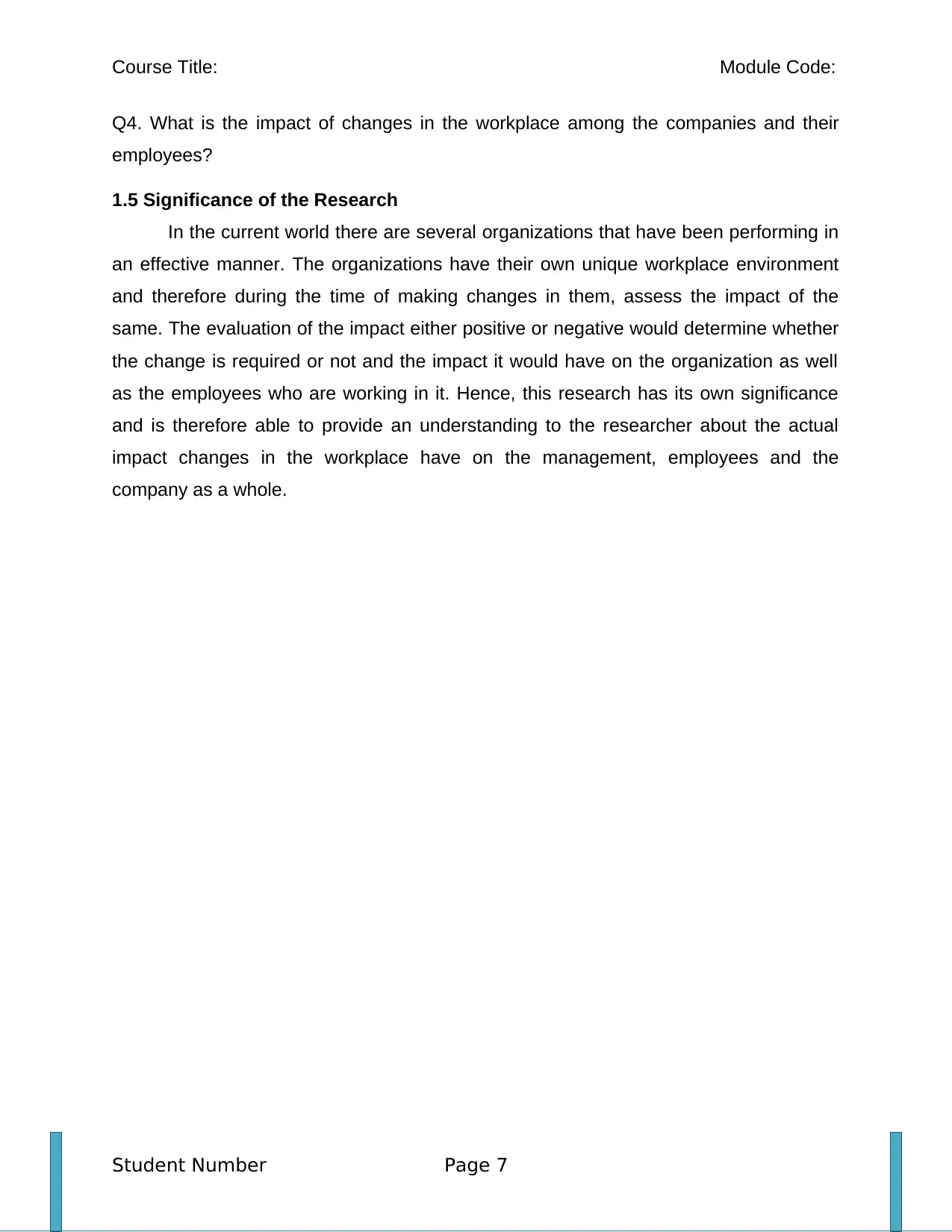
Course Title: Module Code:
Q4. What is the impact of changes in the workplace among the companies and their
employees?
1.5 Significance of the Research
In the current world there are several organizations that have been performing in
an effective manner. The organizations have their own unique workplace environment
and therefore during the time of making changes in them, assess the impact of the
same. The evaluation of the impact either positive or negative would determine whether
the change is required or not and the impact it would have on the organization as well
as the employees who are working in it. Hence, this research has its own significance
and is therefore able to provide an understanding to the researcher about the actual
impact changes in the workplace have on the management, employees and the
company as a whole.
Student Number Page 7
Q4. What is the impact of changes in the workplace among the companies and their
employees?
1.5 Significance of the Research
In the current world there are several organizations that have been performing in
an effective manner. The organizations have their own unique workplace environment
and therefore during the time of making changes in them, assess the impact of the
same. The evaluation of the impact either positive or negative would determine whether
the change is required or not and the impact it would have on the organization as well
as the employees who are working in it. Hence, this research has its own significance
and is therefore able to provide an understanding to the researcher about the actual
impact changes in the workplace have on the management, employees and the
company as a whole.
Student Number Page 7
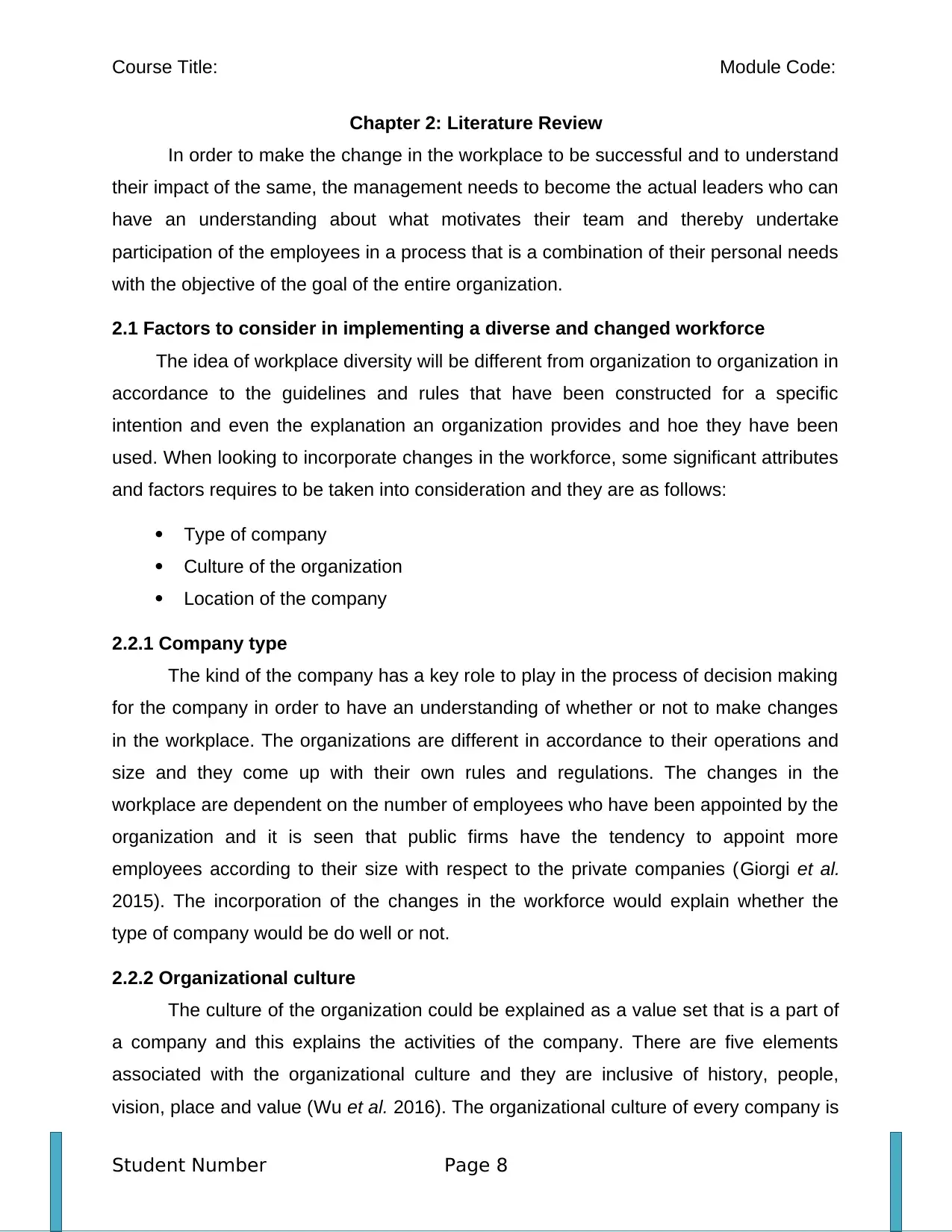
Course Title: Module Code:
Chapter 2: Literature Review
In order to make the change in the workplace to be successful and to understand
their impact of the same, the management needs to become the actual leaders who can
have an understanding about what motivates their team and thereby undertake
participation of the employees in a process that is a combination of their personal needs
with the objective of the goal of the entire organization.
2.1 Factors to consider in implementing a diverse and changed workforce
The idea of workplace diversity will be different from organization to organization in
accordance to the guidelines and rules that have been constructed for a specific
intention and even the explanation an organization provides and hoe they have been
used. When looking to incorporate changes in the workforce, some significant attributes
and factors requires to be taken into consideration and they are as follows:
Type of company
Culture of the organization
Location of the company
2.2.1 Company type
The kind of the company has a key role to play in the process of decision making
for the company in order to have an understanding of whether or not to make changes
in the workplace. The organizations are different in accordance to their operations and
size and they come up with their own rules and regulations. The changes in the
workplace are dependent on the number of employees who have been appointed by the
organization and it is seen that public firms have the tendency to appoint more
employees according to their size with respect to the private companies (Giorgi et al.
2015). The incorporation of the changes in the workforce would explain whether the
type of company would be do well or not.
2.2.2 Organizational culture
The culture of the organization could be explained as a value set that is a part of
a company and this explains the activities of the company. There are five elements
associated with the organizational culture and they are inclusive of history, people,
vision, place and value (Wu et al. 2016). The organizational culture of every company is
Student Number Page 8
Chapter 2: Literature Review
In order to make the change in the workplace to be successful and to understand
their impact of the same, the management needs to become the actual leaders who can
have an understanding about what motivates their team and thereby undertake
participation of the employees in a process that is a combination of their personal needs
with the objective of the goal of the entire organization.
2.1 Factors to consider in implementing a diverse and changed workforce
The idea of workplace diversity will be different from organization to organization in
accordance to the guidelines and rules that have been constructed for a specific
intention and even the explanation an organization provides and hoe they have been
used. When looking to incorporate changes in the workforce, some significant attributes
and factors requires to be taken into consideration and they are as follows:
Type of company
Culture of the organization
Location of the company
2.2.1 Company type
The kind of the company has a key role to play in the process of decision making
for the company in order to have an understanding of whether or not to make changes
in the workplace. The organizations are different in accordance to their operations and
size and they come up with their own rules and regulations. The changes in the
workplace are dependent on the number of employees who have been appointed by the
organization and it is seen that public firms have the tendency to appoint more
employees according to their size with respect to the private companies (Giorgi et al.
2015). The incorporation of the changes in the workforce would explain whether the
type of company would be do well or not.
2.2.2 Organizational culture
The culture of the organization could be explained as a value set that is a part of
a company and this explains the activities of the company. There are five elements
associated with the organizational culture and they are inclusive of history, people,
vision, place and value (Wu et al. 2016). The organizational culture of every company is
Student Number Page 8
⊘ This is a preview!⊘
Do you want full access?
Subscribe today to unlock all pages.

Trusted by 1+ million students worldwide
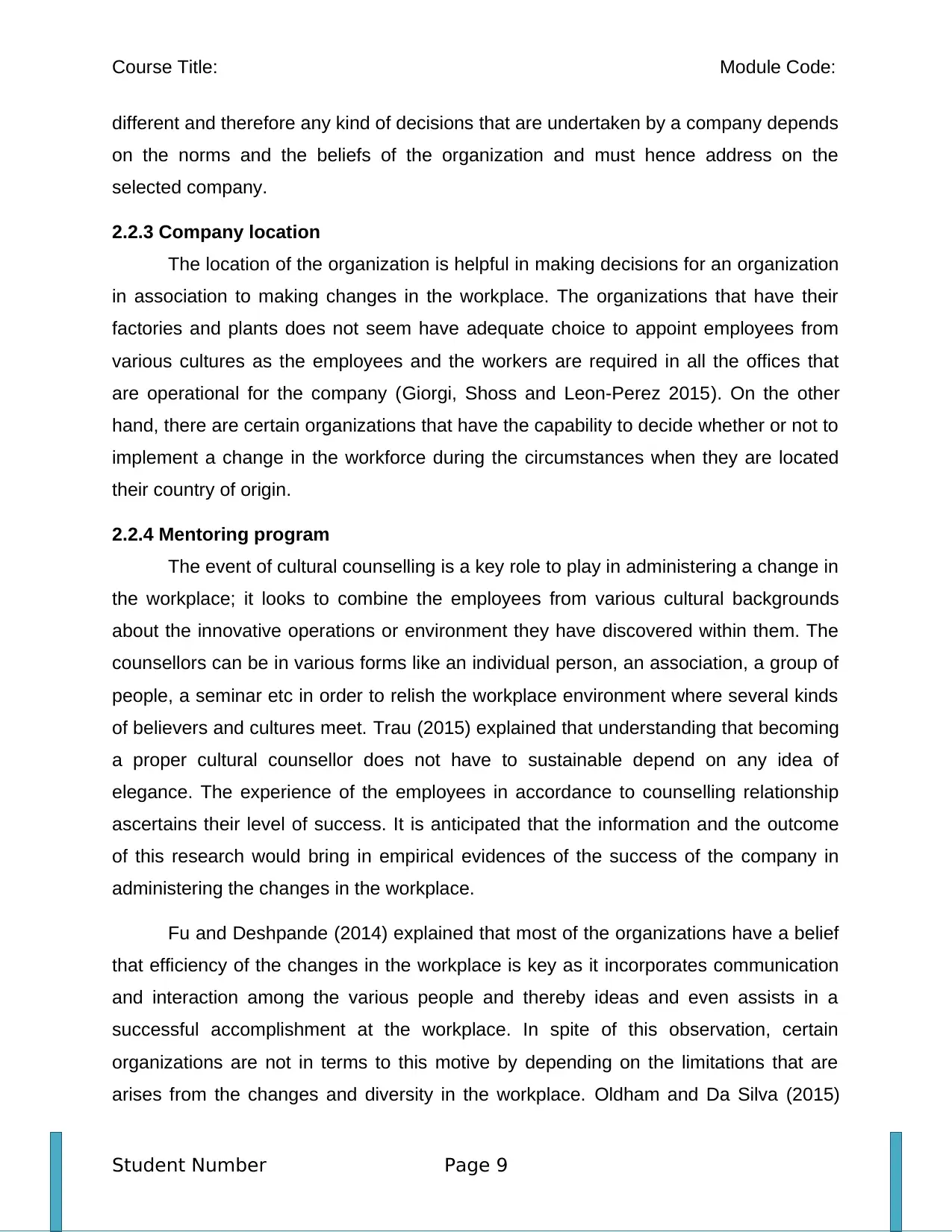
Course Title: Module Code:
different and therefore any kind of decisions that are undertaken by a company depends
on the norms and the beliefs of the organization and must hence address on the
selected company.
2.2.3 Company location
The location of the organization is helpful in making decisions for an organization
in association to making changes in the workplace. The organizations that have their
factories and plants does not seem have adequate choice to appoint employees from
various cultures as the employees and the workers are required in all the offices that
are operational for the company (Giorgi, Shoss and Leon-Perez 2015). On the other
hand, there are certain organizations that have the capability to decide whether or not to
implement a change in the workforce during the circumstances when they are located
their country of origin.
2.2.4 Mentoring program
The event of cultural counselling is a key role to play in administering a change in
the workplace; it looks to combine the employees from various cultural backgrounds
about the innovative operations or environment they have discovered within them. The
counsellors can be in various forms like an individual person, an association, a group of
people, a seminar etc in order to relish the workplace environment where several kinds
of believers and cultures meet. Trau (2015) explained that understanding that becoming
a proper cultural counsellor does not have to sustainable depend on any idea of
elegance. The experience of the employees in accordance to counselling relationship
ascertains their level of success. It is anticipated that the information and the outcome
of this research would bring in empirical evidences of the success of the company in
administering the changes in the workplace.
Fu and Deshpande (2014) explained that most of the organizations have a belief
that efficiency of the changes in the workplace is key as it incorporates communication
and interaction among the various people and thereby ideas and even assists in a
successful accomplishment at the workplace. In spite of this observation, certain
organizations are not in terms to this motive by depending on the limitations that are
arises from the changes and diversity in the workplace. Oldham and Da Silva (2015)
Student Number Page 9
different and therefore any kind of decisions that are undertaken by a company depends
on the norms and the beliefs of the organization and must hence address on the
selected company.
2.2.3 Company location
The location of the organization is helpful in making decisions for an organization
in association to making changes in the workplace. The organizations that have their
factories and plants does not seem have adequate choice to appoint employees from
various cultures as the employees and the workers are required in all the offices that
are operational for the company (Giorgi, Shoss and Leon-Perez 2015). On the other
hand, there are certain organizations that have the capability to decide whether or not to
implement a change in the workforce during the circumstances when they are located
their country of origin.
2.2.4 Mentoring program
The event of cultural counselling is a key role to play in administering a change in
the workplace; it looks to combine the employees from various cultural backgrounds
about the innovative operations or environment they have discovered within them. The
counsellors can be in various forms like an individual person, an association, a group of
people, a seminar etc in order to relish the workplace environment where several kinds
of believers and cultures meet. Trau (2015) explained that understanding that becoming
a proper cultural counsellor does not have to sustainable depend on any idea of
elegance. The experience of the employees in accordance to counselling relationship
ascertains their level of success. It is anticipated that the information and the outcome
of this research would bring in empirical evidences of the success of the company in
administering the changes in the workplace.
Fu and Deshpande (2014) explained that most of the organizations have a belief
that efficiency of the changes in the workplace is key as it incorporates communication
and interaction among the various people and thereby ideas and even assists in a
successful accomplishment at the workplace. In spite of this observation, certain
organizations are not in terms to this motive by depending on the limitations that are
arises from the changes and diversity in the workplace. Oldham and Da Silva (2015)
Student Number Page 9
Paraphrase This Document
Need a fresh take? Get an instant paraphrase of this document with our AI Paraphraser
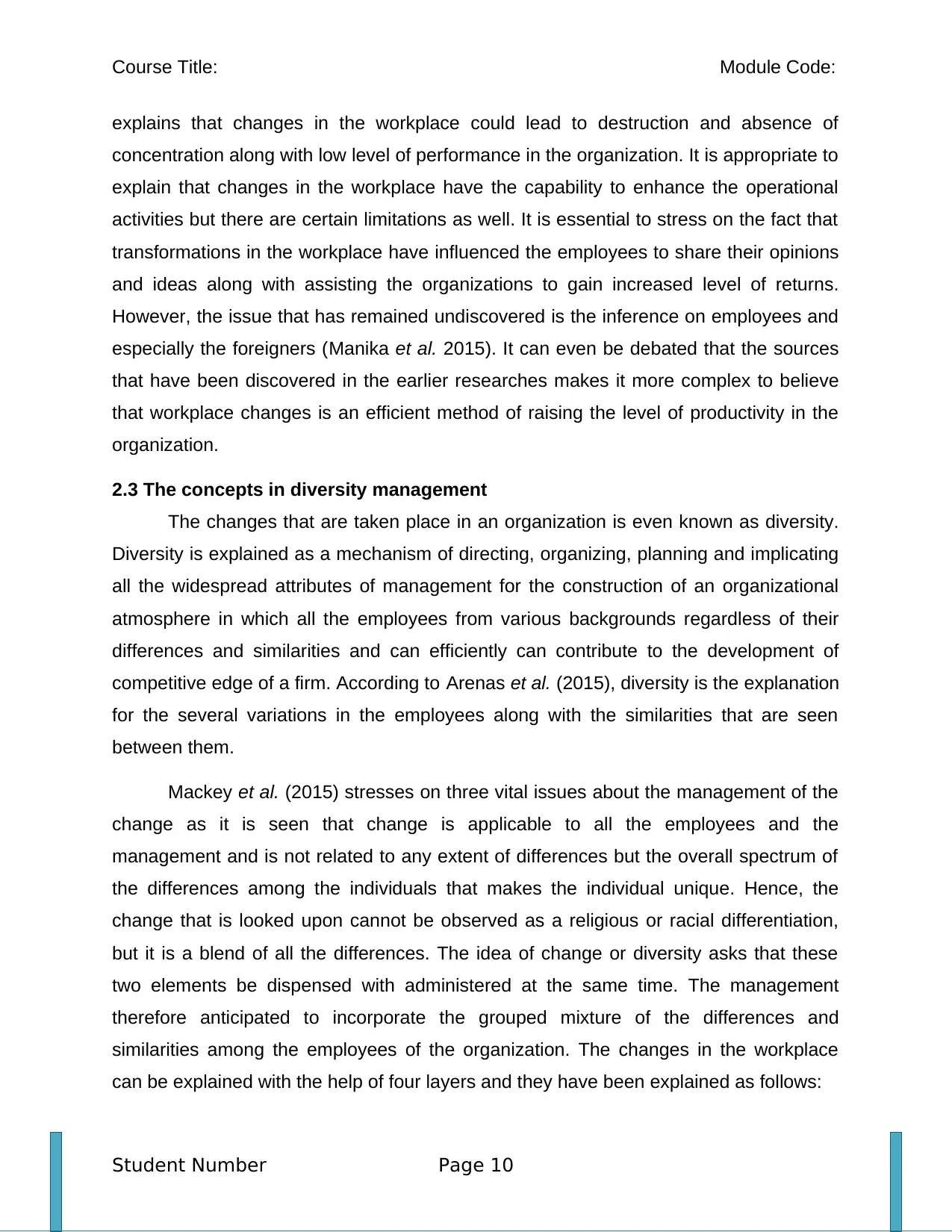
Course Title: Module Code:
explains that changes in the workplace could lead to destruction and absence of
concentration along with low level of performance in the organization. It is appropriate to
explain that changes in the workplace have the capability to enhance the operational
activities but there are certain limitations as well. It is essential to stress on the fact that
transformations in the workplace have influenced the employees to share their opinions
and ideas along with assisting the organizations to gain increased level of returns.
However, the issue that has remained undiscovered is the inference on employees and
especially the foreigners (Manika et al. 2015). It can even be debated that the sources
that have been discovered in the earlier researches makes it more complex to believe
that workplace changes is an efficient method of raising the level of productivity in the
organization.
2.3 The concepts in diversity management
The changes that are taken place in an organization is even known as diversity.
Diversity is explained as a mechanism of directing, organizing, planning and implicating
all the widespread attributes of management for the construction of an organizational
atmosphere in which all the employees from various backgrounds regardless of their
differences and similarities and can efficiently can contribute to the development of
competitive edge of a firm. According to Arenas et al. (2015), diversity is the explanation
for the several variations in the employees along with the similarities that are seen
between them.
Mackey et al. (2015) stresses on three vital issues about the management of the
change as it is seen that change is applicable to all the employees and the
management and is not related to any extent of differences but the overall spectrum of
the differences among the individuals that makes the individual unique. Hence, the
change that is looked upon cannot be observed as a religious or racial differentiation,
but it is a blend of all the differences. The idea of change or diversity asks that these
two elements be dispensed with administered at the same time. The management
therefore anticipated to incorporate the grouped mixture of the differences and
similarities among the employees of the organization. The changes in the workplace
can be explained with the help of four layers and they have been explained as follows:
Student Number Page 10
explains that changes in the workplace could lead to destruction and absence of
concentration along with low level of performance in the organization. It is appropriate to
explain that changes in the workplace have the capability to enhance the operational
activities but there are certain limitations as well. It is essential to stress on the fact that
transformations in the workplace have influenced the employees to share their opinions
and ideas along with assisting the organizations to gain increased level of returns.
However, the issue that has remained undiscovered is the inference on employees and
especially the foreigners (Manika et al. 2015). It can even be debated that the sources
that have been discovered in the earlier researches makes it more complex to believe
that workplace changes is an efficient method of raising the level of productivity in the
organization.
2.3 The concepts in diversity management
The changes that are taken place in an organization is even known as diversity.
Diversity is explained as a mechanism of directing, organizing, planning and implicating
all the widespread attributes of management for the construction of an organizational
atmosphere in which all the employees from various backgrounds regardless of their
differences and similarities and can efficiently can contribute to the development of
competitive edge of a firm. According to Arenas et al. (2015), diversity is the explanation
for the several variations in the employees along with the similarities that are seen
between them.
Mackey et al. (2015) stresses on three vital issues about the management of the
change as it is seen that change is applicable to all the employees and the
management and is not related to any extent of differences but the overall spectrum of
the differences among the individuals that makes the individual unique. Hence, the
change that is looked upon cannot be observed as a religious or racial differentiation,
but it is a blend of all the differences. The idea of change or diversity asks that these
two elements be dispensed with administered at the same time. The management
therefore anticipated to incorporate the grouped mixture of the differences and
similarities among the employees of the organization. The changes in the workplace
can be explained with the help of four layers and they have been explained as follows:
Student Number Page 10
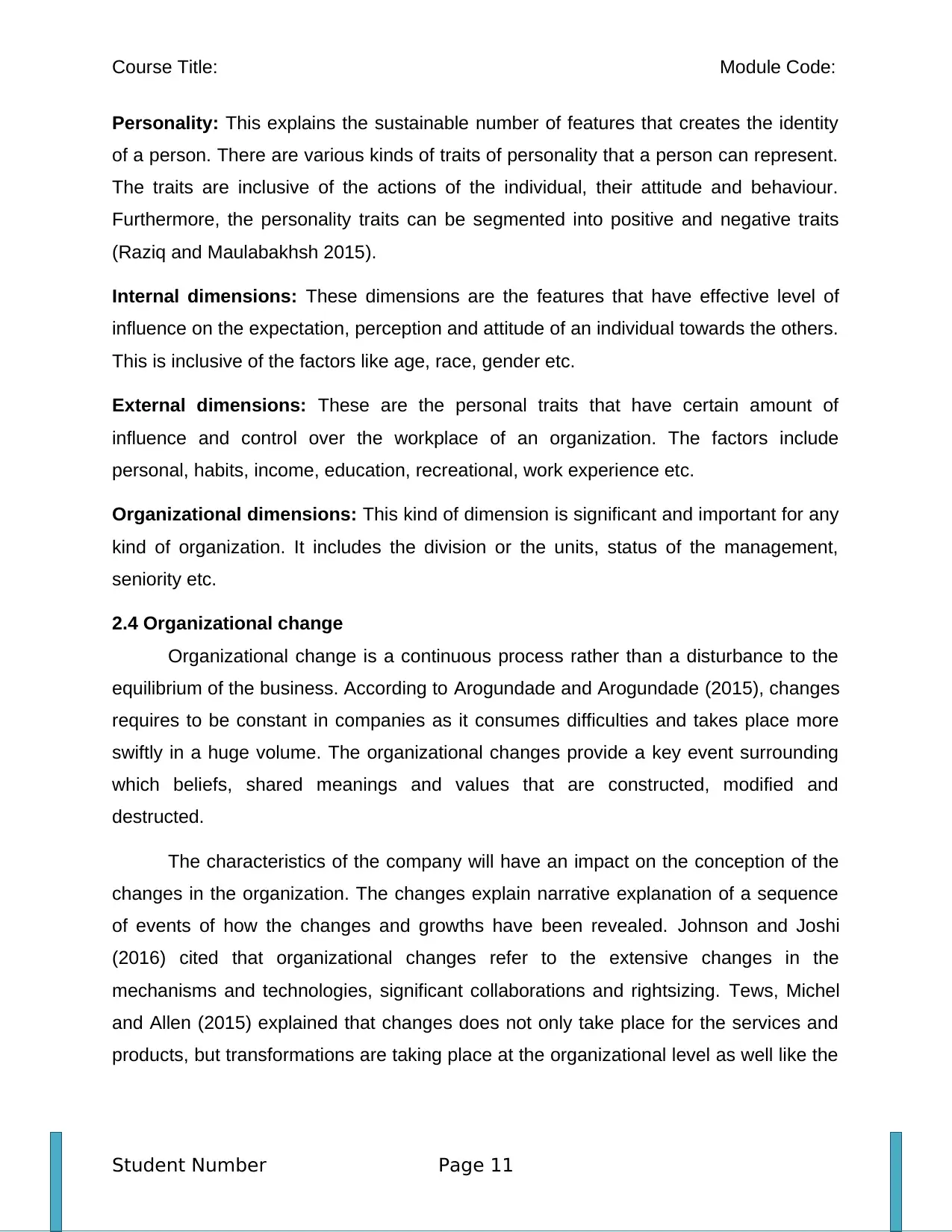
Course Title: Module Code:
Personality: This explains the sustainable number of features that creates the identity
of a person. There are various kinds of traits of personality that a person can represent.
The traits are inclusive of the actions of the individual, their attitude and behaviour.
Furthermore, the personality traits can be segmented into positive and negative traits
(Raziq and Maulabakhsh 2015).
Internal dimensions: These dimensions are the features that have effective level of
influence on the expectation, perception and attitude of an individual towards the others.
This is inclusive of the factors like age, race, gender etc.
External dimensions: These are the personal traits that have certain amount of
influence and control over the workplace of an organization. The factors include
personal, habits, income, education, recreational, work experience etc.
Organizational dimensions: This kind of dimension is significant and important for any
kind of organization. It includes the division or the units, status of the management,
seniority etc.
2.4 Organizational change
Organizational change is a continuous process rather than a disturbance to the
equilibrium of the business. According to Arogundade and Arogundade (2015), changes
requires to be constant in companies as it consumes difficulties and takes place more
swiftly in a huge volume. The organizational changes provide a key event surrounding
which beliefs, shared meanings and values that are constructed, modified and
destructed.
The characteristics of the company will have an impact on the conception of the
changes in the organization. The changes explain narrative explanation of a sequence
of events of how the changes and growths have been revealed. Johnson and Joshi
(2016) cited that organizational changes refer to the extensive changes in the
mechanisms and technologies, significant collaborations and rightsizing. Tews, Michel
and Allen (2015) explained that changes does not only take place for the services and
products, but transformations are taking place at the organizational level as well like the
Student Number Page 11
Personality: This explains the sustainable number of features that creates the identity
of a person. There are various kinds of traits of personality that a person can represent.
The traits are inclusive of the actions of the individual, their attitude and behaviour.
Furthermore, the personality traits can be segmented into positive and negative traits
(Raziq and Maulabakhsh 2015).
Internal dimensions: These dimensions are the features that have effective level of
influence on the expectation, perception and attitude of an individual towards the others.
This is inclusive of the factors like age, race, gender etc.
External dimensions: These are the personal traits that have certain amount of
influence and control over the workplace of an organization. The factors include
personal, habits, income, education, recreational, work experience etc.
Organizational dimensions: This kind of dimension is significant and important for any
kind of organization. It includes the division or the units, status of the management,
seniority etc.
2.4 Organizational change
Organizational change is a continuous process rather than a disturbance to the
equilibrium of the business. According to Arogundade and Arogundade (2015), changes
requires to be constant in companies as it consumes difficulties and takes place more
swiftly in a huge volume. The organizational changes provide a key event surrounding
which beliefs, shared meanings and values that are constructed, modified and
destructed.
The characteristics of the company will have an impact on the conception of the
changes in the organization. The changes explain narrative explanation of a sequence
of events of how the changes and growths have been revealed. Johnson and Joshi
(2016) cited that organizational changes refer to the extensive changes in the
mechanisms and technologies, significant collaborations and rightsizing. Tews, Michel
and Allen (2015) explained that changes does not only take place for the services and
products, but transformations are taking place at the organizational level as well like the
Student Number Page 11
⊘ This is a preview!⊘
Do you want full access?
Subscribe today to unlock all pages.

Trusted by 1+ million students worldwide
1 out of 45
Related Documents
Your All-in-One AI-Powered Toolkit for Academic Success.
+13062052269
info@desklib.com
Available 24*7 on WhatsApp / Email
![[object Object]](/_next/static/media/star-bottom.7253800d.svg)
Unlock your academic potential
Copyright © 2020–2025 A2Z Services. All Rights Reserved. Developed and managed by ZUCOL.





